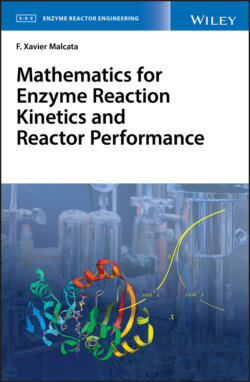Читать книгу Mathematics for Enzyme Reaction Kinetics and Reactor Performance - F. Xavier Malcata - Страница 13
Оглавление
Preface
Quality is not an act, it is a habit.
Aristotle
Mathematics for Enzyme Reaction Kinetics and Reactor Performance is the first set in a unique 11‐volume collection on Enzyme Reactor Engineering. This two‐volume set relates specifically to the mathematical background – required for systematic and rational simulation of both reaction kinetics and reactor performance, and to fully understand and capitalize on the modelling concepts developed; it accordingly reviews basic and useful concepts of Algebra (first volume), and Calculus and Statistics (second volume).
A brief overview of such native algebraic entities as scalars, vectors, matrices, and determinants constitutes the starting point of the first volume; the major features of germane functions are then addressed – namely, polynomials and series (and their operative algebra), as well as trigonometric and hyperbolic functions. Vector operations ensue, with results either of scalar or vector nature, complemented by tensor/matrix operations and their properties. The calculation of determinants is considered next – with an emphasis on their underlying characteristics, and use to find eigenvalues and -vectors. Finally, exact methods for solution of selected algebraic equations, including sets of linear equations, are addressed – as well as numerical methods for utilization at large.
The second volume departs from introduction of seminal concepts in calculus, i.e. limits, derivatives, integrals, and differential equations; limits, along with continuity, are further expanded afterward, covering uni‐ and multi‐variate cases, as well as classical theorems. After recovering the concept of differential and applying it to generate (regular and partial) derivatives, the most important rules of differentiation of functions (in explicit, implicit, and parametric forms) are retrieved – and the most relevant theorems supporting simpler manipulation thereof are reviewed. Once the conditions for independence of functions are put forward, the strategies to optimize uni‐ and multi-variate functions are tackled – either in the presence or absence of constraints. The concept of integral is finally discussed, in both indefinite and definite forms – and the fundamental theorems are brought on board, along with the rules of integration. Furthermore, optimization of integrals is discussed, as part of calculus of variations. Practical applications of the concept of derivative follow – namely, for development of Taylor’s series and setting of associated convergence criteria; and also of the concept of integral – namely, to define the gamma function and to take advantage of its ubiquitous properties. Due to their relevance in reactor modelling, fundamental concepts in analytical geometry are recalled – with an emphasis on curves, surfaces, and volumes bearing simple (yet representative) shapes. Finally, the working horse of process modelling is covered to some length – i.e. (ordinary) differential equations, including such useful tools for solution thereof as Laplace’s integral (and Legendre’s derivative) transforms – with a brief excursion to solution of (first order) partial differential equations. The most important methods of analytical solution available are duly reviewed and eventually complemented with simple numerical approaches to integration. The final topic is vector calculus – where the nuclear del operator is introduced, and the most important applications to scalar and vector entities are developed as identities expressed in rectangular coordinates; an extension is made later to cylindrical and spherical coordinates, for the sake of completeness.
The second volume ends with a brief coverage of statistics – starting with continuous probability functions and statistical descriptors, and proceeding to discussion in depth of the normal distribution; such other continuous distributions as lognormal, chi‐square, Student's t‐, and Fisher's F‐distributions are reviewed next – spanning from mathematical derivation, through calculation of major descriptors, to discussion of most relevant features (including generation of distinct continuous probability functions). Statistical hypothesis testing is addressed next, complemented with the alternative approach of parameter and prediction inference – resorting to linear regression analysis as germane mode of parameter estimation.
F. Xavier Malcata Professor of Chemical Engineering University of Porto (Portugal)
